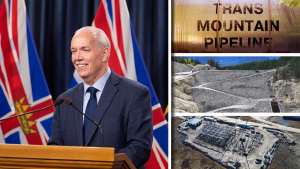The prospects of rising commodity prices, volatility in energy markets and unreliable supply chains portend a rough ride for Canadian constructors in future, commodities expert Francisco Blanch warned delegates tuned in to the virtual CanaData conference held recently.
Blanch, the head of global commodities with the Bank of America Merrill Lynch, was introduced and interviewed by ��������Connect chief economist Alex Carrick during the Sept. 28 session, with Carrick making the case for linking commodities and Canadian construction balance sheets.
“��������ion firms think of commodities mostly in terms of how it causes increases in costs, driving up the cost of building materials like asphalt and plastic pipes and everything,” explained Carrick.
“But there’s the other side of this, and that is for Canada, higher prices can lead to better trade-balance sheets, leading to investment in commodities and raw materials, which is positive for construction.”
Blanch spent much of his presentation discussing Chinese markets, including its shaky property sector and its huge demand for commodities, because as China’s economy goes, so goes the rest of the world, he said. China represents a huge percentage of the global demand for raw materials essential to construction and the green economy, Blanch noted, with its share of steel 29 per cent of global demand, and with 27 per cent of global zinc demand, 21 per cent of aluminum, 11 per cent of copper and 10 per cent of nickel.
Rising demand and thus prices for essential supplies in China is a problem for Canadian constructors and the opposite is true as well.
“If we see a slowdown in China, we could see some benefits to developers from lower prices,” Blanch said, referring to steel and aluminum.
China’s property sector is currently in decline. Real estate loans in China look to fall well below five-per-cent growth in 2021, compared with almost 25-per-cent growth year over year in 2018. Housing and floor space starts both declined in the past year in China.Blanch reported that aluminum smelters are running into electricity constraints in China, driving prices steadily higher, and mandated steel production cuts of 12.6 per cent in August in China are driving iron ore prices higher as well.
Overall, the recovery in China is starting to tail off, with steel demand slowing over the declines in property and auto. Steel demand was down significantly in July.
Globally, Blanch foresees oil possibly reaching $100 per barrel this winter, especially if it’s a cold winter in China. Natural gas prices are also escalating, with low European storage capacity and high Asian demand combining to create upward pressure.
“I keep seeing more and more price shocks building across the energy supply chain,” said Blanch.
Oil prices have held up better than expected due to steep OPEC-plus production cuts and improving demand, Blanch observed, with driving mobility – personal transportation in cars – rebounding, led by the U.S.
“The macro picture is one of uncertainty, one of over-reliance on fiscal and monetary (policy) to stimulate the economy, an economy that, by the way, has been subject to multiple supply shocks,” Blanch said of the global picture. “It’s not just that we have shortages of computers, we have shortages of many raw materials that go into producing a lot of the goods and services our economy consumes today.”
Breakdowns in supply chains are being exacerbated by nationalism and other political trends of recent years. And pandemic recovery strategies taken by countries like Canada and most others – “spend, spend, spend” – are adding to supply price hikes, Blanch said.
Those strategies that “hand out money to the population are essentially driving these prices,” he said.
Carrick and Blanch also discussed the global cost impacts of the accelerating greening of the economy, saying that too could lead to higher prices and volatility.
The issues are that governments are spending significant amounts of tax revenues merely to support the transition, rather than typical capacity expansion, and at this point the new sources of green energy are unreliable.
“We’ve tried to move too fast towards the net-zero targets, 2050, 2060, which is fine,” said Blanch. “And maybe we end up saving the planet. So it’s going to be difficult to avoid extremely high and volatile energy prices throughout this transition. I think we’re getting the first glimpse of what the future looks like.”
Meanwhile, approximately 25 per cent of the world’s tax revenues are going towards climate change measures.
“Once the bills start arriving and people realize that we are not investing in capacity, we’re not investing in improving our status of living, we’re just outright investing in decarbonizing… this is taking away essentially a quarter of all tax revenues,” he said.
Follow the author on Twitter .











Recent Comments
comments for this post are closed